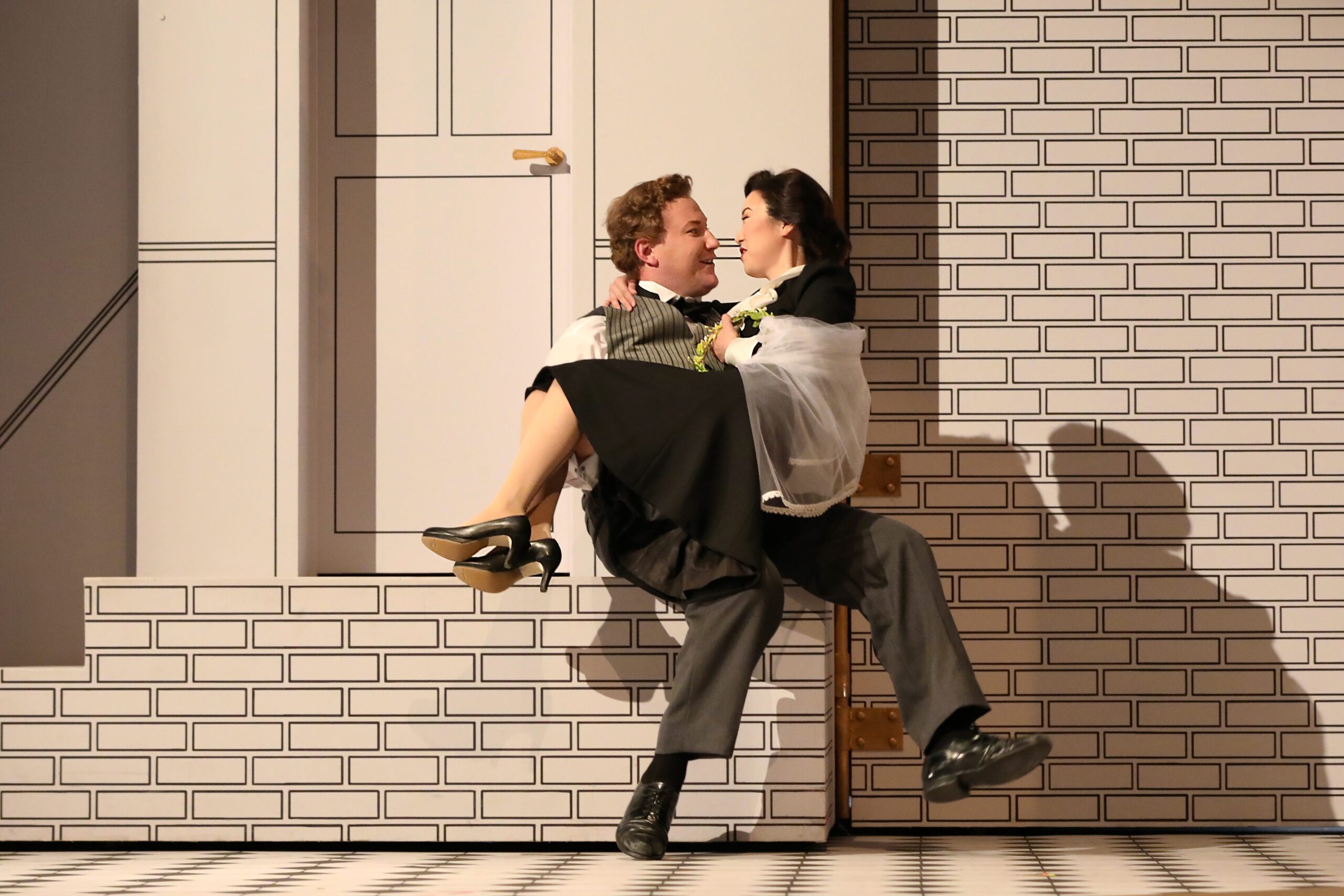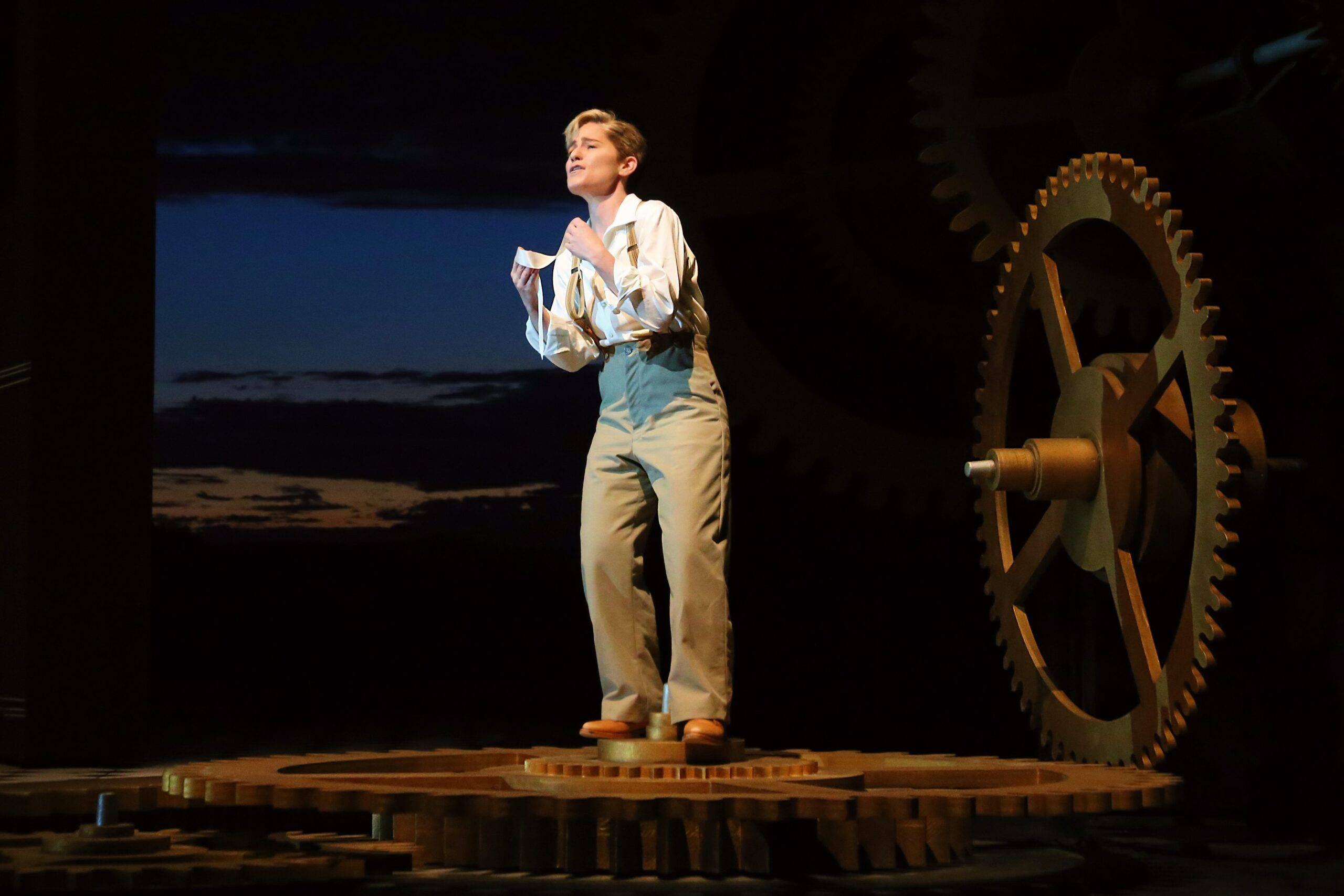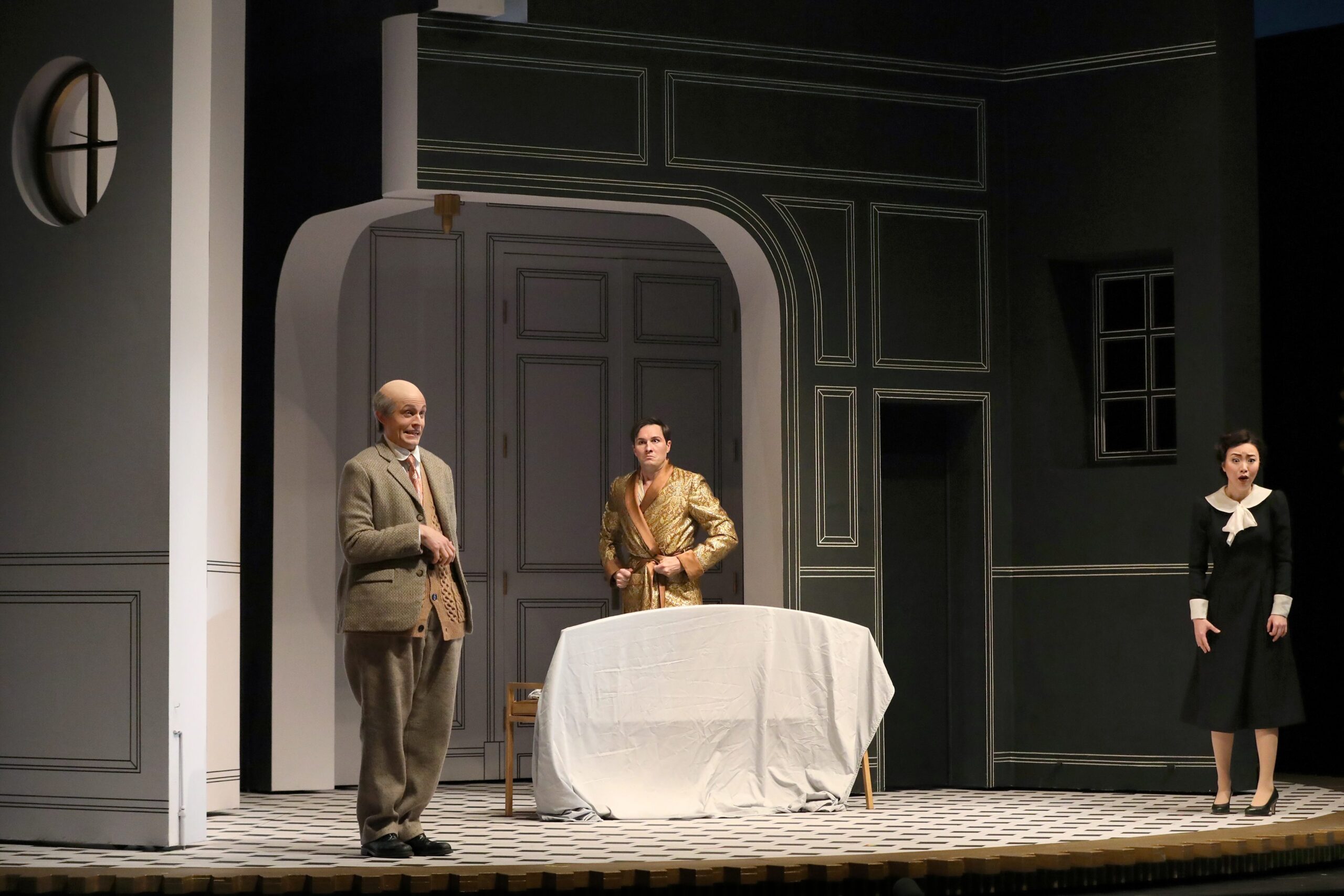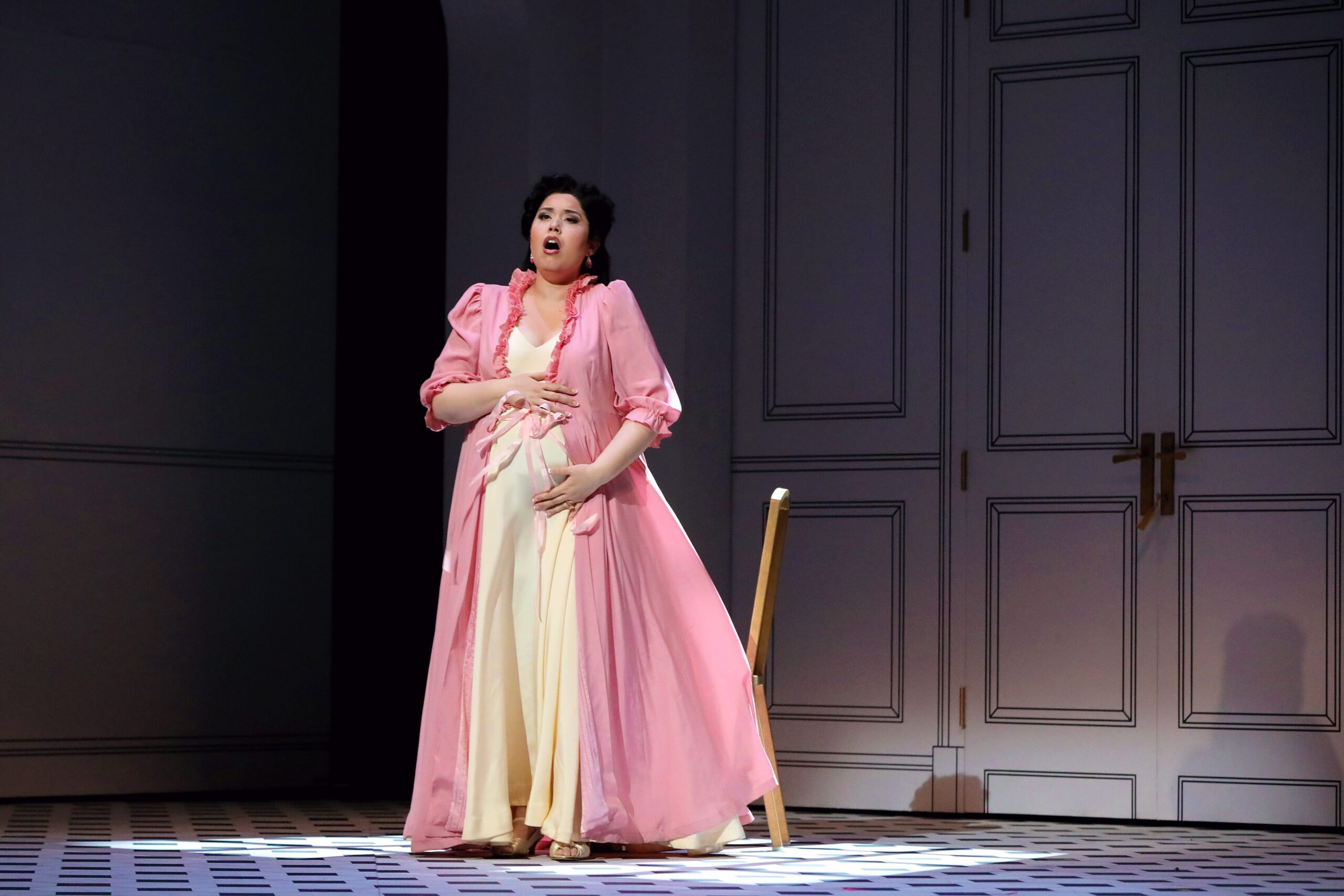Like the barber in another famous piece, Santa Fe Opera’s The Marriage of Figaro (Le nozze di Figaro) is frequently all over the place.
There may be a number of reasons for this, the difficulty of getting visas for foreign artists during COVID restrictions chief among them. This turned out to be somewhat a Marriage of inconvenience. Acclaimed director Laurent Pelly could not travel, so his assistant Laurie Feldman gamely took over, reportedly using recordings and Zoom meetings to keep Pelly involved as best as possible. But effective comedy requires detailed characterization and carefully calibrated interaction to work. And those were sometimes in rather short supply.

First, though, the cast that SFO has assembled is second to none in starry stature. Bass-baritone
Nicholas Brownlee was himself replacing an international artist originally cast but unable to come. Mr. Brownlee was a marvelously accomplished Figaro, with a beefy, manly tone that rang out with pleasing fluidity. He knows the basic way around the role, and lands many of his key moments with aplomb, although he will likely find even more variety with further experience in this title part.
As Susanna, the pert, diminutive Ying Fang is a sterling soprano, pleasantly full toned for such a soubrette role, easily encompassing melting phrasing, sassy rejoinders, and all the many challenges of this lengthy sing. She is delightfully at ease on stage, even when asked to gamely communicate some sexually charged gestures. Given their substantial individual gifts, it is a shame then, that she and Mr. Brownlee could not ignite more crackling connectivity between their characters. (See: Housebound French Director, above.)
Samuel Dale Johnson was an uncommonly fine choice for Count Almaviva, with his lean, lanky, Casanova good looks and a refined, pointed baritone possessed of an attractive timbre and presence. His initial scenes made him seem like a lizard in search of a lounge. First appearing in pajamas and a dressing gown, he opened his robe a few too many times to provocatively suggest “exposing” his business to Susanna, at one point coming up close behind her to ensure she, um, gets the point. To his great credit, Mr. Johnson goes on from this “ick” directorial moment to create one of the show’s most well-rounded impersonations, not least with a searing account of Almaviva’s Act Three aria.

Vanessa Vasquez, a visibly pregnant Countess Almaviva (what resonance that had!) displayed a creamy, warm, alluring soprano that has full-bodied lyric qualities verging on spinto. Porgi amor is a difficult sing, an entrance aria that has to nobly dispel any dodgy conceptions we have about her from Act One’s gossipy chatter. Attempting to be introspective, Ms. Vasquez pulled her delivery too far back, and she seemed unnecessarily tentative. Her Act Three showpiece was delivered with comparative assurance, and indeed she shone brightly in her extensive ensemble work.
Megan Marino was a spirited, well-rounded Cherubino, who arguably came off the best overall in rising above the routine of the proceedings. Ms. Marino’s cherubic appearance, sizable and well-schooled mezzo, and unself-consciously hormone driven “male” presentation (she/him/they) utterly won me over. Patrick Carfizzi made a substantial contribution to the evening’s enjoyment with a well-schooled turn as Doctor Bartolo. Mr. Carfizzi’s potent, smooth bass-baritone was more successfully baritone than bass, but while he may not command a booming bottom register, this savvy pro know how to deliver the goods with superior style and diction.
Veteran mezzo Suzanne Mentzer knows every inch of the conniving Marcellina and delivers the musical and theatrical goods with wicked glee. If her lower middle voice is not as fulsome as in prior years, she nevertheless managed her substantial vocal resources to fine effect. Brenton Ryan mutes and colors his tenor to create quite a truly unlikable, sycophantic Don Basilio. Mr. Ryan also deploys the full impact of his pleasant lyric instrument to good effect in the important Act One trio.

Bass James Creswell sang the role of Antonio more fully than many another interpreter, still managing to communicate the drunken gardener without simply barking his way through it. His impressive, incisive instrument would be wonderful to hear in another assignment. From the Apprentice roster: Cheyane Coss’ soprano lilted charmingly as Barbarina; tenor Thomas Cilluffo reveled in his brief spotlight as Don Curzio; and Alaysha Fox (soprano) and Ruby Dibble (mezzo-soprano) were a harmonious duo as the Bridesmaids. The few choral moments were well executed as prepared by Chorus Master Susanne Sheston.
The production was not greatly helped by Chantal Thomas’ impressive but needlessly complicated set design. The basic look is imposing, with a huge modular structure on a turntable flanked by interconnected golden gears of various sizes on either side. These could be an evocation of the machinations of the plot, or as one write-up suggested, a nod to the watchmaker Beaumarchais, on whose play Da Ponte based his libretto.
It has to be said the very first time it moved during the overture, with the gears all turning, it was impressive. The opening device of having the cast lining up upstage and coming into view one by one on the perimeter of the turntable and then disappearing again upstage was clever. But then the damn thing wouldn’t stop turning. And unfolding. And re-configuring. And being stage pinned into one location. And then unpinned and moved into another. And there were more doors than needed for Bluebeard’s Castle.

Midway through Act One, I mused that even Architectural Digest couldn’t draft the improbable floor plan of this palace. Scenes began in one place and ended in another, sometimes passing through a third in the process. As an anecdote goes that was once leveled at a fidgety, overly busy actor: Don’t just do something, stand there.
Mr. Pelly and Jean-Jacques Delmotte’s costume design, rooted in a rather somber, mid-Twentieth Century period, was effective enough, and ably characterized the participants’ social stations. The gifted lighting guru, Duane Schuler was asked to craft a design that was by turns powerfully evocative, deliberately moody, and maddeningly shadowy. Why are some brilliant finishes of musical selections ended in gloom?
The tone for the evening was set at Harry Bicket’s downbeat. An undernourished first few restless bars from the pit were mirrored by a restless, unsettled audience who seemed not fully aware that the music had started. Full attention was really not achieved until Mr. Carfizzi’s commanding presentation of Bartolo’s aria. But if you haven’t engaged the audience until then, it is a rough slog to get us interested in Figaro and Susanna’s plight. Maestro Bicket is, of course, a conductor of the first tier but on this occasion, partly owing to some lax tempo choices, the performance just stubbornly refused to fully catch fire, content instead to carry on at a pleasant enough low simmer.
Who knows what might have been possible had Mr. Pelly been able to direct in person? He might have tamed the excesses of the over-used set moves. Or maybe gotten this prodigiously talented cast to bond more fully. Or retrieved the humor that was glossed over. I have nothing but admiration for SFO to carry on as best as possible with spunk and purpose, but in this case COVID unfortunately intervened to make this an artistic opportunity missed.
In the resulting production on display, this particular Team Mozart, while still providing considerable enjoyment in individual achievements, was not able to collectively fully illuminate the masterpiece that is The Marriage of Figaro.
James Sohre
The Marriage of Figaro
Music by Wolfgang Amadeus Mozart
Libretto by Lorenzo Da Ponte
Figaro: Nicholas Brownlee; Susanna: Ying Fang; Doctor Bartolo: Patrick Carfizzi; Marcellina: Susanne Mentzer; Cherubino: Megan Marino; Count Almaviva: Samuel Dale Johnson; Don Basilio: Brenton Ryan; Countess Almaviva: Vanessa Vasquez; Antonio: James Creswell; Don Curzio, Thomas Cilluffo; Barbarina: Cheyane Coss; Bridesmaids: Alaysha Fox, Ruby Dibble; Conductor: Harry Bicket; Director: Laurie Feldman, after a concept by Laurent Pelly; Scenic Design: Chantal Thomas; Costume Design: Laurent Pelly, Jean-Jacques Delmotte; Lighting Design: Duane Schuler; Chorus Master: Susanne Shelton
Above: Ying Fang (Susanna). Photo Credit: Curtis Brown For The Santa Fe Opera, 2021